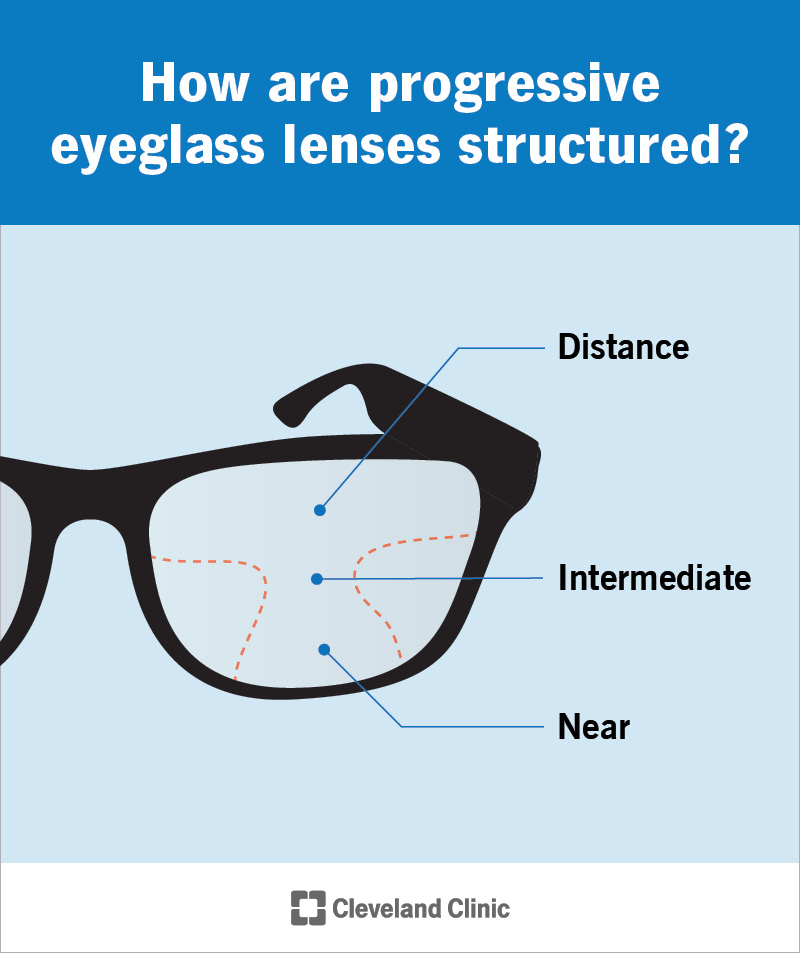Adults with presbyopia or children with myopia may prefer progressive lenses to bifocals or trifocals. Progressive lenses, also called multifocal lenses, give you three zones of vision — near, middle vision and far — in one lens without lines. You may need time to get used to seeing out of them.
Advertisement
Cleveland Clinic is a non-profit academic medical center. Advertising on our site helps support our mission. We do not endorse non-Cleveland Clinic products or services. Policy

Progressive lenses are multifocal lenses that correct your vision. “Multifocal” means they have more than one area of focus so you can see clearly at varying distances. They can help you see up-close tasks like reading, middle-distance tasks like watching TV and far-distance tasks like driving, all while wearing the same pair of glasses.
Advertisement
Cleveland Clinic is a non-profit academic medical center. Advertising on our site helps support our mission. We do not endorse non-Cleveland Clinic products or services. Policy
Multifocal lenses and progressive lenses are the same thing. Another name for these is progressive addition lenses (PALs). Progressive lenses work in the same way as bifocals and trifocals, but there are no lines in the lenses to mark the place where the prescription power changes. You can have progressive lenses if you have contact lenses or eyeglasses.
Progressive lenses treat many vision problems, including difficulties reading up close (presbyopia), which happens to almost everyone after the age of 40.
Types of progressive lenses include:
Advertisement
You’ll need an eye exam to determine how well you can see. The eye care specialist will also ask you questions about your medical history and any symptoms you might have.
During the exam, the provider will ask you to determine when you can see the most clearly. They’ll ask you to choose the lens prescriptions that allow you to see best for distance and for reading.
Potential benefits of progressive lenses include:
Progressive lenses don’t really have risks or complications, but they may have some disadvantages, including:
The time it takes to get used to progressive lenses varies with each person. Some people may need only a week or so to become comfortable with these lenses. Other people may need much longer — up to a couple of months. Some people may choose to use bifocals and trifocals again.
You may need to remind yourself to look through the top part of your lenses to see far away, the middle part to see middle distances and the bottom to see near things.
It’s important for both adults and children to have regular eye exams, often on a schedule of every one to two years. Call an eye care provider if you or your child has any changes in vision. Make sure you get a proper fitting from an ophthalmologist, optometrist or optician.
With younger kids, you can look for things that indicate problems seeing, like squinting or moving things closer to see them.
Ask the provider about progressive lenses if you’re interested in having them.
Improving eyesight has never been easier than it is now. If you’re older than 40, you may have presbyopia. (Presbyopia is the Greek word for “old eyes.”) If you don’t want to look like you’re old enough to have old eyes, you may want progressive lenses. These lenses let you shift between focus areas without the telltale lines of bifocals or trifocals. Progressive lenses may also be useful for children who are nearsighted.
Advertisement
Progressive lenses need correct fitting to provide the best vision. It’s important to get regular eye exams and to have professional eye specialists fit your corrective lenses.
Advertisement
Cleveland Clinic’s ophthalmologists and optometrists have the highest training available. We provide exams, vision correction and care for many eye conditions.

Last reviewed on 10/02/2023.
Learn more about the Health Library and our editorial process.